Self-cleaning Viking ovens offer a convenient and efficient way to maintain your appliance․ This feature uses high heat to reduce food residue to ash, simplifying cleanup․ Always follow the manufacturer’s guidelines for safe and effective cleaning․
Overview of the Self-Cleaning Feature
The self-cleaning feature on Viking ovens utilizes high heat to reduce food residue to ash, making cleanup effortless; This process typically takes several hours, during which the oven locks to ensure safety․ Before starting, remove racks, utensils, and excessive debris to prevent smoke or flare-ups․ Proper ventilation is crucial to avoid fumes and odors․ The oven will remain hot during and after the cycle, requiring caution․ Follow the manufacturer’s instructions precisely to ensure optimal results and safety․ This feature eliminates the need for harsh chemicals, promoting a healthier cleaning process․ Regular use of the self-clean cycle helps maintain your oven’s performance and appearance․ Always refer to the Use and Care Manual for specific guidelines tailored to your Viking oven model․
Benefits of Using the Self-Clean Cycle
The self-clean cycle offers numerous advantages for maintaining your Viking oven․ It eliminates the need for harsh chemicals, making it a safer and more environmentally friendly option․ High heat reduces tough food residue to ash, which is easy to wipe away after cooling․ This feature also helps maintain oven efficiency by removing grease buildup that can affect performance․ Regular use extends the lifespan of your appliance and keeps it looking like new․ Additionally, the process is hands-off, saving time and effort compared to manual cleaning․ By following the manufacturer’s instructions, you ensure a thorough and safe cleaning experience․ This cycle is a convenient solution for keeping your oven in optimal condition, enhancing both its functionality and appearance over time․
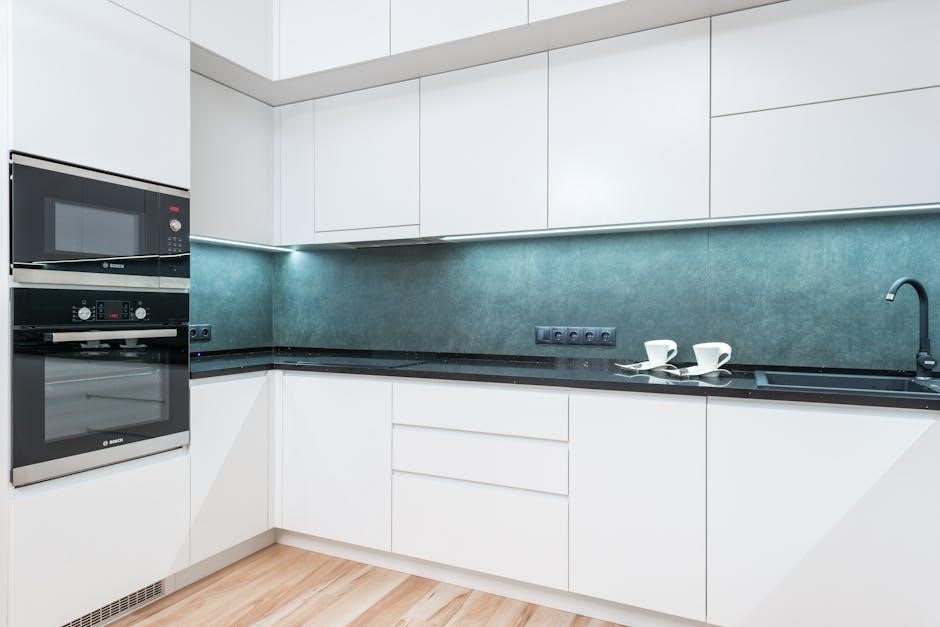
Preparing for the Self-Clean Cycle
Before initiating the self-clean cycle, ensure the oven is empty of racks, utensils, and food debris․ Remove broiler pans, grids, and rack supports to prevent damage․ Always refer to the Use and Care Manual for specific instructions;
Removing Oven Racks and Utensils
Before starting the self-clean cycle, it is essential to remove all oven racks, utensils, and accessories․ This includes broiler pans, grids, and rack supports․ Leaving these items inside can cause damage or discoloration due to high temperatures․ Use oven mitts or tongs to carefully take out racks and place them in a safe area for cleaning․ Wipe up any excessive food spillovers to prevent smoke and flare-ups during the cycle․ Ensure the oven is completely empty to allow proper airflow and even heating․ Refer to your Viking oven’s Use and Care Manual for specific instructions on removing parts․ This step ensures a safe and effective cleaning process, preventing any potential hazards or damage to your appliance․
Protecting Surroundings from Heat and Odors
When preparing for the self-clean cycle, it is crucial to protect your surroundings from excessive heat and odors․ Open windows and ensure proper ventilation to prevent the accumulation of fumes․ Use an exhaust fan to circulate air and reduce strong smells․ Cover nearby surfaces with heat-resistant materials or towels to avoid damage from radiant heat․ Avoid running the self-clean cycle during peak heat hours to minimize the strain on your home’s cooling system․ Additionally, ensure the oven door is completely closed to contain heat and odors․ By taking these precautions, you can safeguard your kitchen and household from the intense conditions generated during the cleaning process․ These steps are essential for maintaining a safe and comfortable environment while using the self-clean feature on your Viking oven․
Ensuring Safety Before Starting
Before initiating the self-clean cycle, ensure a safe environment by clearing the area around the oven․ Turn on your kitchen’s exhaust fan to minimize fumes and odors․ Keep children and pets away, as the oven door will lock and emit intense heat․ Remove all utensils, racks, and accessories to prevent damage․ Avoid wearing loose clothing that could catch fire․ Verify that the oven is completely empty, including broiler pans and grids, to prevent smoke or flare-ups․ Never use the self-clean feature if the oven is damaged or malfunctioning․ Stay present during the cycle to monitor progress and address any issues promptly․ By following these precautions, you can ensure a safe and effective cleaning process for your Viking oven․

Operating the Self-Clean Cycle
Operating the Self-Clean Cycle involves closing the oven door, turning the selector knob to SELF CLEAN, setting the desired temperature, and pressing Start․ Follow the on-screen instructions carefully․
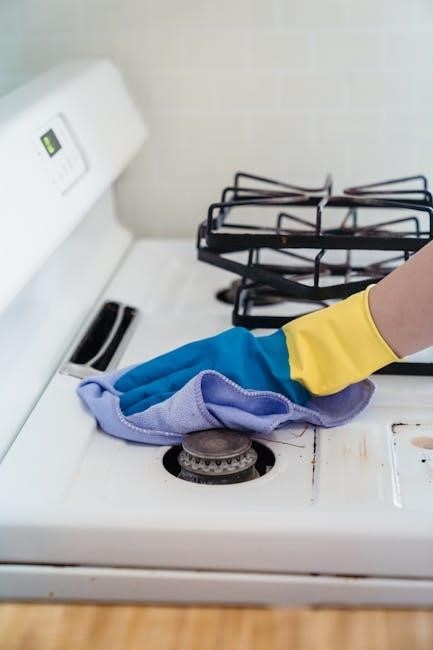
Step-by-Step Activation of the Self-Clean Mode
Activate the self-clean mode by closing the oven door completely․ Turn the oven selector knob clockwise to the SELF CLEAN setting․ Next, set the temperature control knob to the desired cleaning level․ Press the Start button to initiate the cycle․ Follow any additional on-screen instructions provided by the oven’s interface․ Ensure the oven is empty of racks and utensils before starting․ The self-clean cycle will begin, using high heat to break down food residue․ Monitor the process and allow the oven to cool before wiping away ash․ Always refer to your Viking oven’s Use and Care Manual for specific instructions and safety guidelines․
Understanding the Duration and Process
The self-clean cycle typically lasts approximately 3 to 4 hours, depending on the selected cleaning level and oven model․ During this process, the oven heats to a high temperature, reducing food residue to ash․ The oven door locks automatically to ensure safety and maintain internal heat․ Once the cycle completes, allow the oven to cool before opening the door․ After cooling, wipe out the ash with a damp cloth and mild detergent․ It’s important to avoid using abrasive cleaners or harsh chemicals to prevent damage to the oven’s finish․ Always follow the manufacturer’s instructions for specific time durations and care tips to ensure optimal results and maintain your Viking oven’s performance․ Properly completing the self-clean cycle helps keep your oven in excellent condition for future use․
Post-Cycle Procedures and Oven Unlocking
After the self-clean cycle completes, the oven will automatically unlock once it has cooled down sufficiently․ This cooling process typically takes about an hour, depending on the oven model and the intensity of the cleaning cycle․ Once unlocked, open the door and carefully wipe out the ash and residue using a damp cloth or sponge․ Avoid using abrasive cleaners or scrubbers, as they may damage the oven’s interior finish․ For tougher residue, a mixture of water and mild detergent can be effective․ Ensure all racks and utensils are cleaned separately and replaced before the next use․ Always refer to your Viking oven’s user manual for specific post-cycle instructions, as procedures may vary slightly by model․ Regularly performing these steps helps maintain your oven’s efficiency and appearance․

Safety Precautions and Considerations
Always follow manufacturer guidelines for the self-clean cycle to ensure safety․ Proper ventilation is crucial to prevent exposure to harmful fumes․ Keep children away during cleaning․
Essential Safety Measures During Cleaning
Always follow the manufacturer’s instructions for the self-clean cycle to ensure safety․ Remove all oven racks, utensils, and the broiler pan before starting the cycle․ Keep the oven door closed during cleaning to prevent exposure to extreme heat and fumes․ Ensure proper ventilation in your kitchen to avoid the accumulation of harmful fumes․ Never leave the oven unattended while it is in the self-clean mode․ Keep children and pets away from the oven during the cleaning process․ Avoid using harsh chemicals or abrasive cleaners, as they may damage the oven’s finish․ Do not use the oven for cooking or storage during the self-clean cycle․ After the cycle is complete, allow the oven to cool down before opening the door or wiping down surfaces․ Always wear oven mitts or use tongs to handle racks or utensils after cleaning․
Importance of Ventilation
Proper ventilation is crucial when using the self-clean cycle on your Viking oven․ The high heat generated during this process releases fumes and odors, which can be harmful if inhaled in large quantities․ Open windows and doors to ensure good airflow in your kitchen․ Use an exhaust fan to help remove fumes more efficiently․ Avoid recirculating air within the kitchen, as this can trap unpleasant smells and potentially harmful particles․ Inadequate ventilation may lead to lingering odors or even smoke buildup, which can be difficult to eliminate․ Ensuring proper ventilation not only enhances safety but also helps maintain a comfortable cooking environment․ Always prioritize airflow to make the self-cleaning process safer and more effective․ This step is essential for protecting both your health and your home during the cleaning cycle․
Avoiding Harsh Chemicals and Abrasives
Using harsh chemicals or abrasive cleaners on your Viking oven can damage the interior surfaces, including the finish and glass components․ These products may leave residue or scratch the oven walls, compromising its appearance and functionality․ Instead, rely on the self-clean cycle to handle tough food residue, as it is designed to break down grime safely․ For lighter cleaning or spot removal, use gentle, non-abrasive cleaners or natural solutions like baking soda and water․ Avoid scouring pads or steel wool, as they can scratch the surfaces․ Always follow the manufacturer’s recommendations for cleaning products to ensure the longevity of your appliance․ Harsh chemicals can also release harmful fumes during the self-clean cycle, so it’s best to avoid them altogether․ Stick to safe, gentle methods to maintain your oven’s condition and performance․
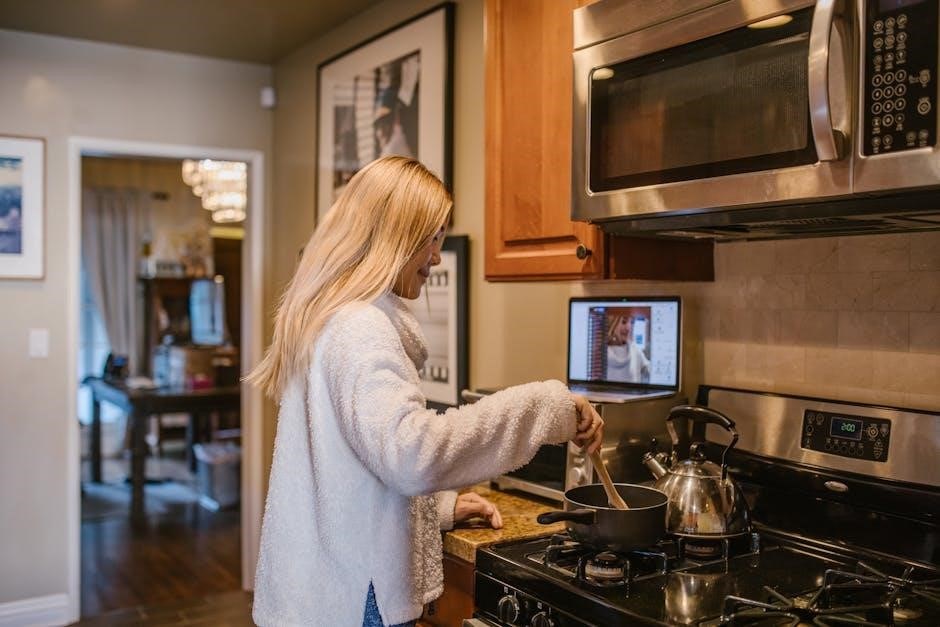
Cleaning the Oven Door and Glass
For the door and glass, remove food residue with a damp cloth․ Use a baking soda paste for tough stains, applying it and wiping clean after sitting․ Avoid harsh chemicals to prevent damage․
Effective Methods for Glass Cleaning
Cleaning the glass on your Viking oven door can be done effectively with simple, non-abrasive methods․ Start by wiping away loose food particles with a damp cloth; For tougher stains, create a paste using baking soda and water, then apply it to the glass․ Let it sit for about 15 minutes before wiping clean with a soft, damp cloth․ For streak-free results, use a mixture of equal parts water and white vinegar, applied with a lint-free cloth or paper towel․ Avoid using harsh chemicals or abrasive scrubbers, as they can scratch the glass․ For stubborn residue, a gentle glass cleaner specifically designed for ovens can be used, following the product’s instructions․ Regular cleaning will help maintain the clarity and appearance of your oven door glass, ensuring optimal visibility while cooking․
Removing Tough Stains from the Door
Tough stains on your Viking oven door can be challenging, but several methods can help restore its appearance․ For particularly stubborn stains, apply a thick paste made from baking soda and water directly to the affected area․ Let it sit for 30 minutes to an hour before wiping clean with a damp cloth․ If the stain persists, mix equal parts white vinegar and water in a spray bottle and apply it to the stain․ Allow it to sit for 10–15 minutes, then scrub gently with a soft sponge or cloth․ For especially resilient stains, a gentle oven cleaner or a specialized glass cleaner can be used, but always avoid abrasive scrubbers or harsh chemicals that might damage the finish․ Regular maintenance and prompt cleaning will help prevent stains from becoming difficult to remove, keeping your oven door looking its best․
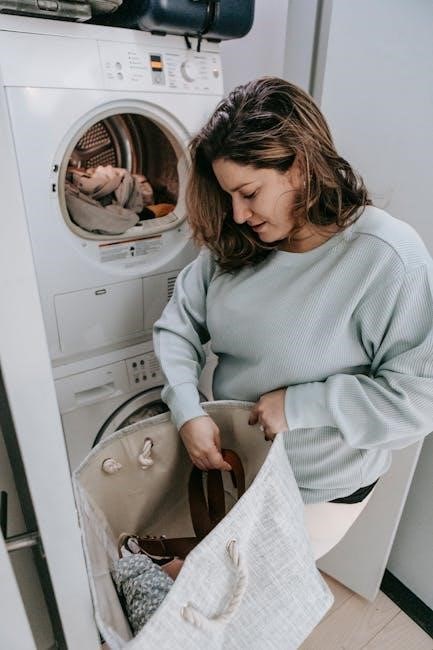
Maintaining Your Viking Oven
Regular maintenance ensures optimal performance and longevity of your Viking oven․ Clean spills promptly, check and replace worn seals, and schedule professional servicing as needed for best results․
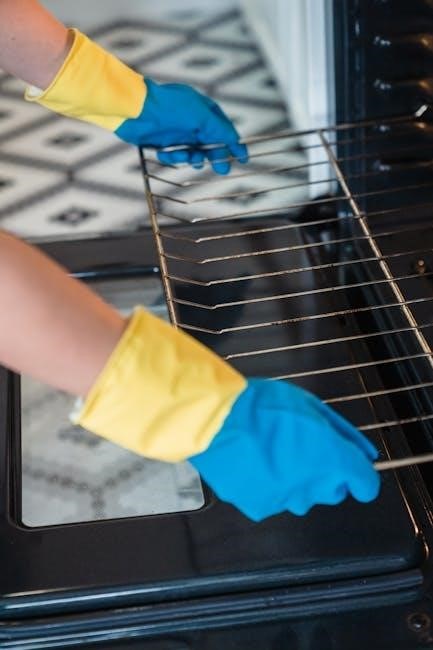
Routine Cleaning and Upkeep Tips
To keep your Viking oven in pristine condition, establish a regular cleaning routine․ After each use, wipe down surfaces with a damp cloth to prevent grease buildup․ For tougher spills, mix baking soda and water to create a paste, apply it to the affected areas, and let it sit overnight before wiping clean․ Avoid using harsh chemicals or abrasive scrubbers, as they can damage the finish․ Additionally, clean the oven racks periodically by soaking them in warm soapy water․ For the exterior, use a microfiber cloth and mild detergent to maintain the stainless steel or other finishes․ Regularly inspect door seals for wear and tear to ensure proper heat retention․ By following these simple tips, you can maintain your Viking oven’s efficiency and appearance for years to come․
Caring for the Exterior Finish
Maintaining the exterior of your Viking oven is essential to preserve its sleek appearance and durability․ Regularly wipe the surfaces with a microfiber cloth to remove fingerprints and smudges․ For tougher stains or grease, use a mild detergent mixed with warm water, applying it with a soft cloth․ Avoid harsh chemicals, abrasive cleaners, or scrubbers, as they can damage the finish․ For stainless steel exteriors, a stainless steel cleaner can be used to maintain shine and resist fingerprints․ Always dry the surface thoroughly after cleaning to prevent water spots․ For other finishes, such as painted or coated surfaces, stick to gentle cleaning products specifically designed for those materials․ By following these care tips, you can keep your Viking oven looking like new and ensure its exterior remains pristine for years․

Troubleshooting Common Issues
Identify and resolve issues promptly to maintain your Viking oven’s performance․ Check error codes, ensure proper operation, and address unexpected odors or noises during the self-clean cycle․
Identifying and Resolving Error Codes
Error codes on your Viking oven indicate specific issues during the self-clean cycle․ Familiarize yourself with common codes like E1 or E2, which often relate to temperature or sensor malfunctions․ Refer to your Use and Care Manual for precise code meanings․ If an error occurs, stop the cycle and allow the oven to cool․ Check for loose connections or faulty sensors․ Reset the oven by switching it off and on․ If the issue persists, contact Viking support or a certified technician․ Never attempt repairs yourself, as this could void the warranty or cause further damage․ Regular maintenance can help prevent errors, ensuring smooth operation during cleaning cycles․ Always follow manufacturer guidelines for troubleshooting to maintain your oven’s efficiency and safety․
Addressing Unpleasant Odors
Unpleasant odors during or after the self-clean cycle can occur due to food residue burning off․ To minimize this, ensure the oven is clean before starting the cycle․ Remove large food particles and wipe up spills to reduce smoke and odors․ Proper ventilation is key—open windows and use an exhaust fan to circulate air․ If odors persist, mix baking soda and water to create a paste, apply it to the interior, and let it sit overnight before wiping clean․ Avoid using harsh chemicals or abrasive cleaners, as they can damage the oven’s finish․ After the cycle, allow the oven to cool before cleaning ash with a damp cloth․ Regular maintenance and gentle cleaning can help prevent lingering smells and keep your Viking oven in optimal condition․ Always follow manufacturer guidelines for safe and effective odor management․
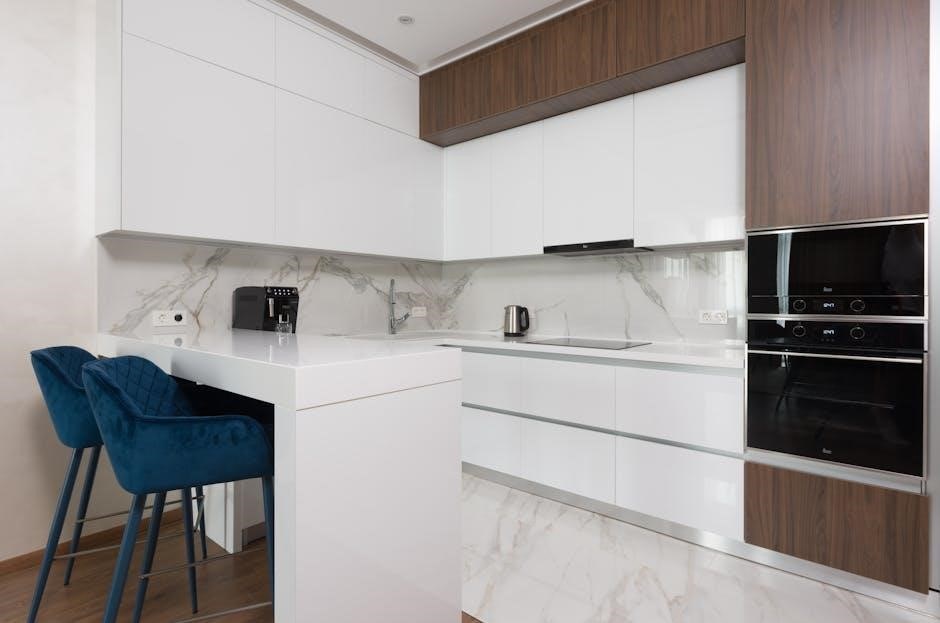
Additional Tips and Best Practices
Regularly inspect and clean oven racks and utensils to prevent food residue buildup․ Clean minor spills immediately to avoid hardening․ Use a gentle cleaner on the exterior to maintain the finish․ Check and replace oven seals if worn․ Keep a cleaning schedule to ensure efficiency and longevity․
Optional Cleaning Solutions
For those who prefer manual cleaning, a mixture of baking soda and water creates a gentle yet effective paste․ Apply it to tough stains, let it sit overnight, and wipe clean with a damp cloth․ Vinegar is another eco-friendly option; soak racks in a vinegar solution to loosen grime․ Steam cleaning can also be used—place a bowl of water in the oven, heat it briefly, and use the steam to soften residue․ Always avoid harsh chemicals and abrasive scrubbers to protect the oven’s finish․ For exterior cleaning, a soft cloth with warm soapy water works best․ Regular maintenance with these methods can keep your Viking oven in pristine condition without relying solely on the self-clean cycle․
Preventing Odors During the Cycle
To minimize unpleasant odors during the self-cleaning cycle, ensure your Viking oven is free from large food particles and spills beforehand․ Wipe up excessive debris with a damp cloth to reduce smoke and fumes․ Proper ventilation is key—open windows and use an exhaust fan to circulate air․ Avoid leaving the oven unattended, as prolonged high heat can intensify smells․ If odors persist, consider shorter cleaning cycles or using a combination of water and baking soda in the oven to absorb odors․ Always follow the manufacturer’s guidelines to ensure safety and optimal results․ Regular maintenance and timely cleaning can significantly reduce strong smells during the self-cleaning process․
Maintaining your Viking oven through regular self-cleaning ensures optimal performance and longevity․ Always follow manufacturer guidelines for safety and efficiency, and address any issues promptly to prevent damage․
Recap of Key Instructions
To effectively use your Viking oven’s self-clean feature, always start by removing racks, utensils, and excess debris․ Ensure the oven door is closed and follow the manufacturer’s instructions for activating the self-clean cycle․ Protect surrounding areas from heat and odors, and ensure proper ventilation to avoid fumes․ Never use harsh chemicals or abrasive cleaners, as they can damage the oven’s finish․ After the cycle, allow the oven to cool before wiping away ash with a damp cloth․ Regular maintenance, such as cleaning the door glass with baking soda paste, will keep your oven in prime condition․ Address error codes promptly and avoid using the oven for non-culinary cleaning tasks․ By adhering to these guidelines, you can maintain your Viking oven’s performance and longevity while ensuring safety and efficiency․
Final Advice for Optimal Use
For optimal use of your Viking oven’s self-cleaning feature, consistency is key․ Regularly remove food residue and spills to prevent heavy buildup․ Always refer to your Use and Care Manual for specific instructions, as settings may vary․ Ensure the oven is cool before wiping down surfaces to avoid burns․ To maintain the exterior, use a soft cloth with warm, soapy water, and dry thoroughly to prevent streaks․ Schedule routine cleaning sessions, ideally every 1-3 months, depending on usage․ During the self-clean cycle, keep the kitchen well-ventilated to minimize odors․ Avoid using abrasive materials that could scratch the oven’s interior or glass․ By following these practices, you’ll preserve your Viking oven’s performance, appearance, and longevity, ensuring it remains a reliable and efficient kitchen companion for years to come․ This approach not only maintains cleanliness but also enhances safety and functionality․